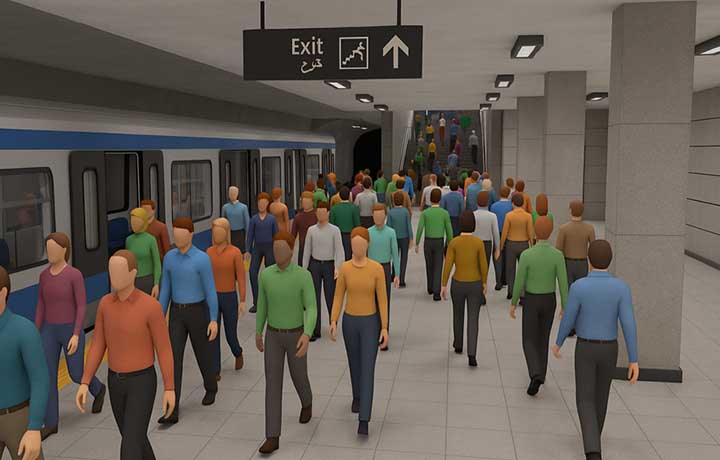
At LAVA Consultants, we use advanced evacuation simulation techniques to assess how people move through metro stations during emergencies. By analysing human behaviour, exit usage, and fire-aligned strategies, we help designers, authorities, and operators ensure that evacuation times remain within accepted limits.
According to NFPA 130, evacuation from the platform to a point of safety must be completed within 4 minutes, while the total evacuation of the station must occur within 6 minutes. These performance thresholds form the foundation for code-based life safety assessments in metro station environments.
However, achieving these benchmarks in real-world conditions can be challenging. Factors such as high passenger volumes, limited exit availability, long travel distances, and complex human behaviours including delayed response, variable walking speeds, and decision-making under stress can significantly impact evacuation timelines. As a result, performance-based analysis using advanced evacuation modelling tools like Pathfinder becomes essential to realistically evaluate egress strategies, validate fire safety designs, and identify areas where improvements are needed to meet both safety objectives and authority expectations.
Pathfinder enables the simulation of realistic crowd movement during emergency scenarios, incorporating variables such as walking speed, route selection, congestion, and behavioural response delays.
In a typical metro station scenario, our simulation accounts for two primary occupant groups:
By modelling these distinct groups, we can evaluate how quickly people clear the platform and reach points of safety, as well as identify potential pinch points. This data plays a vital role in demonstrating compliance, while also helping to inform operational decisions such as escalator usage, signage design, and emergency communication strategies.
Escalator behaviour during evacuation plays an important role in flow capacity. Depending on the fire strategy, escalators may be:
These operational decisions are incorporated into the Pathfinder model to reflect the actual fire response plan during an incident.
Evacuation in metro stations generally follows two primary pathways:
Evacuation simulations are meaningful when they also reflect real human behaviour. In our models, we include factors such as:
Incorporating these human behaviour patterns such as pre-movement delays, varying walking speeds, and decision-making under pressure ensures that the evacuation model outputs are reflective how people respond in high-stress emergency situations.
Our metro evacuation models provide vital performance indicators, including:
Occupant tenability under coordinated fire and smoke modelling (FDS + Pathfinder)
At LAVA Consultants, we have extensive experience in metro station evacuation analysis. Whether you are designing a new metro line, upgrading an existing station, or supporting authority submissions, our evacuation models help you demonstrate life safety compliance with confidence.
© 2025 Lava Consultants. All rights reserved